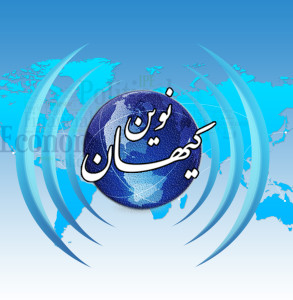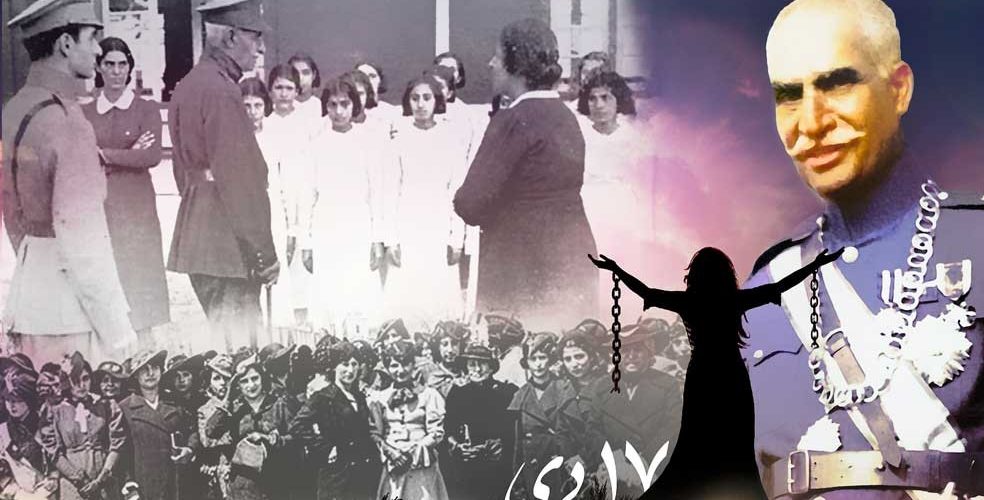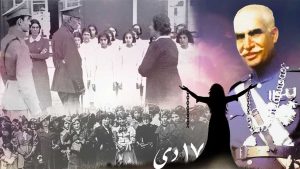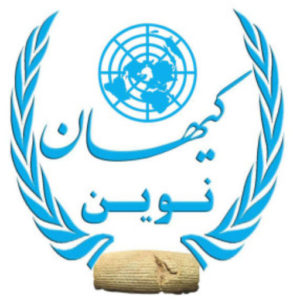«تا کنون نصف جمعیت کشور به حساب نیامده و خانمها را از هرگونه حقی محروم کرده بودند… در صورتی که صرف نظر از وظایف مادری، آنها میتوانند دوشادوش مردها خدماتی را عهدهدار باشند»، «ما میلههای زندان را شکستیم و خانمها آزاد شدند». این جملات را رضاشاه پهلوی ۸۷ سال پیش، در ۱۷ دی ۱۳۱۴ خورشیدی، در جشن دانشسرای مقدماتی دختران بر زبان آورد و آزادی پوشش برای زنان در ایران بطور رسمی آغاز شد.
“Until now, half of the country’s population has not been counted and women were deprived of any rights… In the event that regardless of motherly duties, they can perform services side by side with men”, “We broke the bars of the prison and the women were freed”. These sentences were spoken by Reza Shah Pahlavi 87 years ago, on January 7, 1314, at the celebration of the Girls’ Preparatory School, and the freedom of clothing for women in Iran officially began.
کیهان نوین: آزادی و برابری زنان، در کنار میهندوستی، ضرورت حاکمیت قانون، جایگزینی علم و عقل با خرافات و شریعت، از محوریترین خواستههایی بود که تحقق آن میتوانست ایرانی را که پیش از مشروطه در «لبه پرتگاه» قرار گرفته بود نجات دهد.
یکی از اصلیترین خواستههای زنان در جریان جنبش انقلابی ماههای گذشته از جنس همان خواستههایی است که زنان در اواخر قاجار و در جریان انقلاب مشروطه برای آن مبارزه میکردند و با آغاز حکومت پهلوی با حمایت قانون به دست آوردند: آزادی و برابری حقوقی.
جمهوری اسلامی در کنار باورهای ایدئولوژیک زمامدارانش، با استفادهی ابزاری از زنانی که حجاب اسلامی به آنها تحمیل شده، تلاش داشت ویترین حکومت اسلامی برآمده از انقلاب را بزک کند.
از یکسو اصلاحطلبان و بازوهای صادراتی آنها با «زنانه» قلمداد کردن اعتراضات، جنبش انقلابی مردم برای آزادی را به پوشش اختیاری به عنوان تنها «مطالبه» کاهش میدهند و در آنسو اصولگرایان با کوبیدن بر طبل «حجاب اجباری» همان بازی دوگانهای را پیش میبرند که «تغییر ساختار سیاسی» در آن جایی ندارد.
همانطور که ۱۷ دی ۱۳۱۴ نقطه عطفی در فرآیند نجات ایران از «لبه پرتگاه» شد، «زن زندگی آزادی» نیز ۹ دهه بعد، آغازگر یک انقلاب ملی شده که ایران را از تباهی جمهوری اسلامی به سوی تشکیل حکومتی دموکرات و سکولار پیش خواهد برد.
این جملات اکنون برای زنان ایران و به ویژه زنان جوانی که هویت اجتماعیشان در دوران جمهوری اسلامی شکل گرفته، معنایی عمیقتر یافته است؛ زنانی که این روزها در جریان انقلاب ملّی علیه جمهوری اسلامی، حجاب اجباری از سر برداشته و روسری خود را در خیابان به آتش میکشند. یکی از اصلیترین خواستههای زنان در جریان جنبش انقلابی ماههای اخیر از جنس همان خواستههایی است که زنان در اواخر قاجار و در جریان انقلاب مشروطه برای آن مبارزه میکردند و با آغاز حکومت پهلوی با حمایت قانون به دست آوردند: آزادی و برابری حقوقی.
اما زنان ایران طی یک قرن گذشته از کجا به کجا رسیدهاند؟ جایگاه اجتماعی زنان که نیم قرن پیش تا گذاشتن تاج پادشاهی بر سر زنان کشور توسط پادشاه، محترم و ارزنده شمرده میشد، چطور با انقلاب تباه ۵۷ تا جایی سقوط کرد که متحجرترین قوانین جمهوری اسلامی در حوزه مدنی و کیفری آنها را تحقیر و از حقوق انسانی محروم کند؟
از «کشف حجاب» تا تاج پادشاهی بر سر زن ایرانی
آزادی زنان از جمله آزادی پوشش از اواخر دوران قاجار مطرح بود و در موج مترقی شکلگرفته در دوران انقلاب مشروطه برجسته شد. آزادی و برخورداری از حقوق برابر برای زنانی که سالهای سال در اندرونیها محبوس و در میان پارچههای سیاه پنهان نگه داشته شده بودند، در مقالات نویسندگان آن دوران و اشعار شاعرانی چون میرزاده عشقی، ملکالشعری بهار، عارف قزوینی، پروین اعتصامی و ایرج میرزا بازتاب مییافت.
پروین اعتصامی یکی از پیشروترین زنان جوان آن دوران در خرداد ۱۳۰۱ در جشن فارغالتحصیلیاش سخنرانی کرد. او در بخشی از این سخنرانی که به «اعلامیه زن و تاریخ» معروف شد گفت: «ایران، وطن عزیز ما که مفاخر و مآثر عظیمهٔ آن زینتافزای تاریخ جهان است. ایران که تمدن قدیمش اروپای امروز را رهین منت و مدیون نعمت خویش دارد. ایران با عظمت و قوتی که قرنها بر اقطار و ابحار عالم حکمروا بود، از مصائب و شداید شرق سهم وافر برده، اکنون دنبال گمگشتهٔ خود میدود و به دیدار شاهد نیکبختی میشتابد. پیداست برای مرمت خرابیهای زمان گذشته، اصلاح معایب حالیه، و تمهید سعادت آتیه، چه مشکلاتی در پیش است. ایرانی باید ضعف و ملالت را از خود دور کرده، تند و چالاک این پرتگاهها را عبور نماید. امیدواریم به همت دانشمندان و متفکرین، روح فضیلت در ملت ایجاد شود و با تربیت نسوان اصلاحات مهمهی اجتماعی در ایران فراهم گردد. در این صورت بنای تربیت حقیقی استوار خواهد شد و فرشتهٔ اقبال در فضای مملکت سیروس و داریوش بالگشایی خواهد کرد.»
آزادی و برابری زنان، در کنار میهندوستی، ضرورت حاکمیت قانون، جایگزینی علم و عقل با خرافات و شریعت، از محوریترین خواستههایی بود که تحقق آن میتوانست ایرانی را که پیش از مشروطه در «لبه پرتگاه» قرار گرفته بود نجات دهد.
با بذر کاشته شده توسط روشنفکران مترقی و آزادیخواه در جامعه بود که قانون آزادی پوشش زنان که به «کشف حجاب» معروف شد توانست با استقبال عمومی روبرو شود و بسترساز حضور اجتماعی زنان در آغاز دورهی ایران نوین و مدرن شود.
توسعه اجتماعی و اقتصادی بدون بیرون کشیدن زنان از اندرونیها و ایجاد فرصت برابر برای زنان و مردان امکانپذیر نبود و پادشاهان فقید پهلوی با درک درست همین واقعیت بود که نه تنها به سرعت توانستند برابری جنسیتی را در ایران قانونمند کنند بلکه محمدرضا شاه پهلوی با نهادن تاج بر سر شهبانو فرح پهلوی به عنوان «نایبالسلطنه» آنطور که شهبانو گفته است، تاج را بر سر زنان ایران گذاشت؛ آنهم در سالهایی که در اکثر نقاط جهان حتی در بسیاری از نقاط اروپا زنان حتی از داشتن حق رأی و حمایتهای قانونی مناسب محروم بودند!
توسعه اجتماعی در دوران رضاشاه فقید و توسعه اقتصادی در دوران محمدرضاشاه فقید به سرعت انجام شد و پیش از آنکه برنامه توسعه سیاسی در ایران به عنوان گام سوم رسیدن به ایران مترقی تکمیل شود، انقلاب ۵۷ ورق را برگرداند و ایران را به سالهای پیش از مشروطه، و لبه همان پرتگاه که پروین اعتصامی توصیف کرده بود، پرتاب کرد.
مسیر معکوس و ارتجاعی که از انقلاب ۵۷ برای ایران و ایرانیان رقم خورد، زنان را به قربانیان محوری انقلاب اسلامی تبدیل کرد. جمهوری اسلامی در کنار باورهای ایدئولوژیک زمامدارانش، با استفادهی ابزاری از زنانی که حجاب اسلامی به آنها تحمیل شده، تلاش داشت ویترین حکومت اسلامی برآمده از انقلاب را بزک کند. اما تحمیل حجاب تنها بخشی از خشونتی بود که بر زنان ایران روا میشود. حقوقی که زنان در دوران پادشاهان فقید پهلوی به دست آورده بودند، یکی پس از دیگری از آنها سلب شد. جمهوری اسلامی با احکام شریعت در زمینه حقوق مدنی و کیفری و با ترویج تعدد زوجات و چندهمسری و «کودکهمسری» با حقوق زنان ایران که در قرن بیستم بدیهی مینمود به مقابله پرداخت.
از «یا روسری یا توسری» تا «زن زندگی آزادی»
تئوریسینهای جمهوری اسلامی پس از تشکیل حکومت برآمده از انقلاب ۵۷، امیدوار بودند که با زور و فشار و به اصطلاح فرهنگسازی درباره «زن مسلمان شیعه»، فرآیندی اجتماعی را در ایران شکل دهند که طی آن زنان ایرانی تغییر نگرش داده و کمکم به نیمی از جامعهی «اُمت شیعه» تبدیل شوند.
تحمیل حجاب اجباری به زنان با «یا روسری یا توسری» و اعمال انواع خشونت کلامی، رفتاری و قانونی علیه زنان، از جمله چسباندن پونز به پیشانی آنها از سوی مأمورانی چون اکبر گنجی در سالهای نخست پس از انقلاب آغاز شد و طی سه دهه بعد به گفته مقامات حکومتی ۳۲ دستگاه بطور مستقیم و غیرمستقیم با موضوع حجاب اجباری درگیر بوده و گشت ارشاد اسلامی هم که محصول دولت اصلاحطلب محمد خاتمی است نهاد نظامی زیرشاخهی پلیس امنیت اخلاقی برای این «امر ایدئولوژیک» شد.
«حجاب اجباری» همیشه برای جمهوری اسلامی موضوعی محوری بوده است؛ امرداد امسال و حدود یک ماه پیش از آغاز اعتراضاتی که به شکل جنبش انقلابی و ملی علیه جمهوری اسلامی تداوم یافته، علی خامنهای رهبر جمهوری اسلامی در دیدار با ائمه جمعه موضوع «حجاب» را پیش کشید و ادعا کرد: «غربیها سالها است که میگویند تا زمانی که زن از قیود اخلاقی و شرعی رها نشود، نمیتواند پیشرفت کند و به مدارج عالیِ علمی، سیاسی و اجتماعی برسد اما زن مسلمان ایرانی در بیش از چهل سال گذشته توانسته است با حجاب اسلامی و چادر در میدانهای مختلف علمی، اجتماعی، ورزشی، سیاسی، مدیریتی، اقتصادی و فرهنگی حاضر شود و به موفقیتها و سربلندیهای بزرگ دست یابد.»
جدا از تحریف و دروغی که در سخنان علی خامنهای درباره زنانی که او و حکومتاش آنها را همواره «جنس دوم» و حتا کمتر از نصف مردان به شمار آورده دیده میشود، زن ایرانی اگر طی چهار دهه گذشته توانسته با وجود انواع محدودیتها و خشونتهای تحمیل و تبلیغ شده از سوی جمهوری اسلامی همواره در تلاش و موفق نیز باشد، به دلیل همان میراث فکری و فرهنگی باقیمانده از دوران پیش از انقلاب تباه ۵۷ است!
زنان ایرانی در هفتههای پس از انقلاب ۵۷، نخستین تجمع اعتراضی علیه جمهوری اسلامیِ تازه تأسیس را با تظاهرات علیه حجاب اجباری را در ۱۷ اسفند ۱۳۵۷ برگزار کردند و تا کنون مسیر مخالفت با حجاب تحمیلی همواره ادامه داشته است.
این فرایند در حالی بیش از چهار دهه طول کشیده که حالا ایرانیان سراسر کشور با هر جنسیتی در برابر جمهوری اسلامی ایستاده و جنبشی انقلابی را پیش میبرند که طی چهار ماه، پایداری و همبستگی ملی آنها در داخل و خارج کشور، جهان را به شگفتی وا داشته است.
این جنبش از ۲۶ شهریور ۱۴۰۱ و در پی جان باختن مهسا امینی دختر ۲۲ سالهای که بر اثر ضرب و جرح مأموران گشت ارشاد به کما رفته بود آغاز شد و شعار «زن زندگی آزادی» را جهانی کرد. جان باختن دختر جوانی که به دلیل آنچه از دید مأموران گشت ارشاد، «پوشش نامناسب» و برخلاف قوانین و الگوهای «حجاب اجباری» جمهوری اسلامی ارزیابی شد، به اعتراضاتی انجامید که با گذشت بیش از ۱۱۰ روز میتوان گفت دیگر خاموش شدنی نیست.
اعتراضات مردم در همه استانها و بیش از ۱۶۵ شهر ایران به رستاخیز ملی علیه ظلم ۴۳ ساله جمهوری اسلامی تکامل یافت بطوری که بخش دوم «مرد میهن آبادی» از سوی مردم به شعار اولیهی «زن زندگی آزادی» افزوده شد تا نشان دهد معترضان بسی فراتر از جنسیت و مسئله زنان، به دنبال آزادی و کرامت همه ایرانیانی هستند که طی چهار دهه گذشته توسط جمهوری اسلامی به یغما رفته است؛ آنها، زن و مرد، به دنبال زندگی در میهنی آزاد و آباد هستند.
قابل توجه اینکه با گذشت چهار ماه از انقلاب بزرگ ایرانیان علیه جمهوری اسلامی و در حالی که انواع سرکوب و کشتار نتوانسته مردم را از مسیر انقلاب ملّی بازگرداند، حالا زمامداران حکومت برای حفظ نظام به دنبال راهکاری برای توقف انقلابی هستند که هدفش تغییر رژیم و ساختار سیاسی کشور است.
در چنین شرایطی از یکسو اصلاحطلبان و بازوهای صادراتی آنها با «زنانه» قلمداد کردن اعتراضات، جنبش انقلابی مردم برای آزادی را به پوشش اختیاری به عنوان تنها «مطالبه» کاهش میدهند و در آنسو اصولگرایان با کوبیدن بر طبل «حجاب اجباری» همان بازی دوگانهای را پیش میبرند که «تغییر ساختار سیاسی» در آن جایی ندارد.
به بیان دیگر، تأکید بر صرفا «انقلاب زنانه» و «حجاب» و اصرار بر اینکه این انقلاب، انقلاب «زن زندگی آزادی» است و نفی دیگر ابعاد ملّی و سراسری آن، همگی به نفع جمهوری اسلامی است تا موضوع رستاخیز ملی علیه حکومت به موضوع «حجاب» به عنوان «مطالبه»ای درون چارچوب جمهوری اسلامی کاهش یابد.
اینهمه در حالیست که همانطور که ۱۷ دی ۱۳۱۴ نقطه عطفی در فرآیند نجات ایران از «لبه پرتگاه» شد، «زن زندگی آزادی» نیز ۹ دهه بعد، آغازگر یک انقلاب ملی شده که ایران را از تباهی جمهوری اسلامی به سوی تشکیل حکومتی دموکرات و سکولار پیش خواهد برد.
New Universe:
Women’s freedom and equality, along with patriotism, the necessity of the rule of law, replacing science and reason with superstitions and Sharia, were among the most central demands, the realization of which could save Iran, which was on the “edge of the abyss” before the constitution.
One of the main demands of women during the revolutionary movement of the past months is the same demands that women fought for at the end of Qajar and during the constitutional revolution and obtained with the support of the law with the beginning of Pahlavi rule: freedom and legal equality.
Along with the ideological beliefs of its leaders, the Islamic Republic was trying to showcase the Islamic government that emerged from the revolution by using women who were forced to wear the Islamic hijab as a tool.
On the one hand, the reformists and their export arms, by considering the protests as “feminine”, reduce the people’s revolutionary movement for freedom to voluntary veiling as the only “demand”, and on the other hand, fundamentalists play the same double game by beating the drum of “mandatory hijab”. They say that “changing the political structure” has no place in it.
Just as January 7, 1314 became a turning point in the process of rescuing Iran from the “edge of the abyss”, “The Woman of Freedom” 9 decades later also became the initiator of a national revolution that will lead Iran from the destruction of the Islamic Republic to the establishment of a democratic and secular government. win.
These sentences now have a deeper meaning for Iranian women, especially young women whose social identity was formed during the Islamic Republic. These days, during the national revolution against the Islamic Republic, the women who take off the mandatory hijab and burn their headscarves in the street. One of the main demands of women during the revolutionary movement of recent months is the same demands that women fought for at the end of Qajar and during the constitutional revolution and obtained with the beginning of the Pahlavi rule with the support of the law: freedom and legal equality.
But where have Iranian women reached in the past century? The social status of women, which half a century ago until the king placed the crown on the women of the country, was considered respectable and valuable, how did it fall with the corrupt revolution of 57 to the point where the most petrified laws of the Islamic Republic in the civil and criminal spheres humiliated them and deprived them of their human rights. deprive?
From the “discovery of the hijab” to the crown of the kingdom on the Iranian woman’s head
The freedom of women, including the freedom of clothing, was discussed since the end of the Qajar era and was highlighted in the progressive wave formed during the constitutional revolution. The freedom and enjoyment of equal rights for women, who were locked in inner rooms and hidden among black cloths, were reflected in the articles of writers of that era and the poems of poets such as Mirzadeh Eshghi, Malek al-Shaari Bahar, Aref Qazvini, Parveen Etsami, and Iraj Mirza. .
Parvin Etisami, one of the leading young women of that era, gave a speech at her graduation ceremony in Khordad 1301. In a part of this speech that became known as the “Proclamation of Women and History”, he said: “Iran is our dear homeland, whose great achievements and achievements adorn the history of the world. Iran, whose ancient civilization holds today’s Europe hostage and owes its blessings. Iran, with its greatness and strength, which ruled the world for centuries, has suffered a lot from the sufferings and hardships of the East, now it is running after its lost and hastening to meet the witness of good fortune. It is obvious what problems are ahead to repair the damage of the past, correct the current disadvantages, and prepare for the future prosperity. Iranians must get rid of weakness and boredom and cross these abysses quickly and nimbly. We hope that with the efforts of scientists and thinkers, the spirit of virtue will be created in the nation and important social reforms will be provided in Iran through the education of women. In this case, the foundation of true education will be established and the angel of Iqbal will spread his wings in the country of Cyrus and Darius.
Women’s freedom and equality, along with patriotism, the necessity of the rule of law, replacing science and reason with superstitions and Sharia, were among the most central demands, the realization of which could save Iran, which was on the “edge of the abyss” before the constitution.
It was with the seeds planted by progressive and freedom-loving intellectuals in the society that the law of freedom of women’s clothing, which became known as the “Discovery of the Hijab”, was able to meet with public acceptance and became the basis for the social presence of women at the beginning of the modern Iran.
Social and economic development was not possible without bringing out women from insiders and creating equal opportunities for women and men, and it was the late Pahlavi kings with a correct understanding of this fact that not only were they able to quickly legalize gender equality in Iran, but Mohammad Reza Shah Pahlavi by crowning Farah Pahlavi placed the crown on the head of Iranian women as the “regent” as the queen said. Also, in the years when in most parts of the world, even in many parts of Europe, women were deprived of even having the right to vote and proper legal protections!
Social development during the late Reza Shah era and economic development during the late Mohammad Reza Shah era were done quickly and before the political development program in Iran was completed as the third step to reach a progressive Iran, the revolution turned 57 pages and Iran returned to the years before the constitution. , and threw the edge of the same abyss that Parvin Etsami had described.
The reverse and reactionary path that took place for Iran and Iranians after the 57 revolution made women the main victims of the Islamic revolution. Along with the ideological beliefs of its rulers, the Islamic Republic was trying to display the Islamic government that emerged from the revolution by using the women who were forced to wear the Islamic hijab as a tool. But the imposition of hijab was only part of the violence that is perpetrated on Iranian women. The rights that women had gained during the late Pahlavi kings were stripped from them one after another. The Islamic Republic fought against the rights of Iranian women, which were taken for granted in the 20th century, with Sharia laws in the field of civil and criminal law and by promoting polygamy and polygamy and “child marriage”.
From “either a scarf or a tossari” to “a woman of free life”
The theoreticians of the Islamic Republic, after the formation of the government resulting from the 57 revolution, hoped to shape a social process in Iran through force and pressure and the so-called culture-building about the “Shia Muslim woman”, during which Iranian women changed their attitudes and gradually became half of become the society of “Shia nation”.
The imposition of compulsory hijab on women with “either a headscarf or hairpin” and the use of all kinds of verbal, behavioral and legal violence against women, including the sticking of pons on their foreheads by agents such as Akbar Ganji, began in the first years after the revolution and continued for the next three decades. According to the government authorities, 32 organizations are directly and indirectly involved in the issue of compulsory hijab, and the Islamic Guidance Patrol, which is a product of the reformist government of Mohammad Khatami, became a military institution under the moral security police for this “ideological matter.”
“Mandatory hijab” has always been a central issue for the Islamic Republic; This year, and about a month before the beginning of the protests that have continued in the form of a revolutionary and national movement against the Islamic Republic, the leader of the Islamic Republic, Ali Khamenei, brought up the issue of “Hijab” in a meeting with Friday imams and claimed: “Westerners have been saying for years. Until a woman is freed from moral and religious restrictions, she cannot progress and reach high scientific, political and social levels, but in the past forty years, Iranian Muslim women have been able to wear the Islamic hijab and chador in various scientific, social and sports fields. political, managerial, economic and cultural and achieve great successes and pride.”
Apart from the distortion and lies that can be seen in Ali Khamenei’s words about women whom he and his government have always considered as the “second sex” and even less than half of men, if during the past four decades, Iranian women have been able to, despite all kinds of restrictions and imposed violence and promoted by the Islamic Republic is always trying and successful, because of the intellectual and cultural heritage left from the era before the 57 revolution is ruined!
In the weeks after the 57 revolution, Iranian women held the first protest rally against the newly established Islamic Republic with demonstrations against the mandatory hijab on March 17, 1357, and until now, the path of opposition to the imposed hijab has always continued.
This process has lasted for more than four decades, and now Iranians of all genders across the country are standing against the Islamic Republic and are leading a revolutionary movement that during four months, their stability and national solidarity inside and outside the country has surprised the world. had.
This movement started on 26 Shahrivar 1401 and following the death of Mehsa Amini, a 22-year-old girl who had gone into a coma after being beaten by the officers of the Irshad patrol, and made the slogan “woman of freedom life” universal. The death of a young girl who was assessed as “improper clothing” and contrary to the laws and patterns of “mandatory hijab” in the Islamic Republic, led to protests that after more than 110 days have passed, it can be said that they can no longer be silenced.
People’s protests in all provinces and more than 165 cities of Iran evolved into a national resurrection against the 43-year oppression of the Islamic Republic, so that the second part of “patriotic man” was added by the people to the initial slogan “woman of freedom life” to show that the protesters are much more than that. From the issue of gender and women, they are looking for the freedom and dignity of all Iranians who have been held captive by the Islamic Republic for the past four decades. They, men and women, seek to live in a free and prosperous country.
It is noteworthy that four months have passed since the great revolution of Iranians against the Islamic Republic and while all kinds of repressions and killings have not been able to bring the people back from the path of national revolution, now the government leaders are looking for a way to stop the revolution in order to preserve the system, which aims to change the regime and structure. It is the country’s politics.













